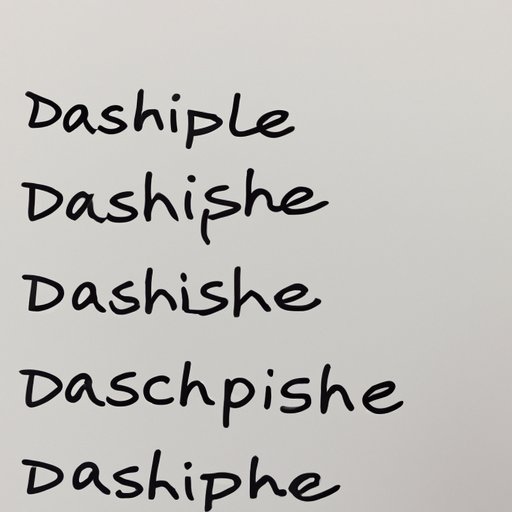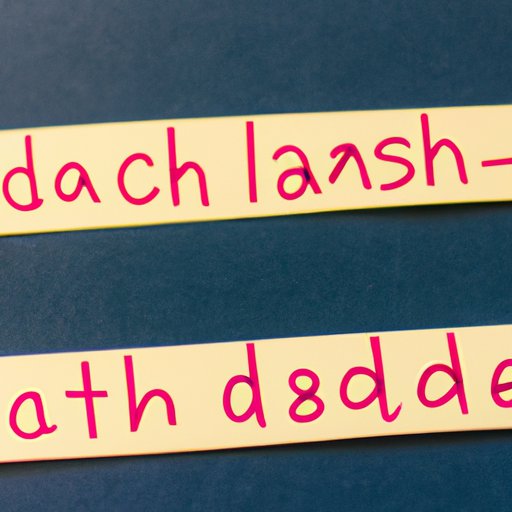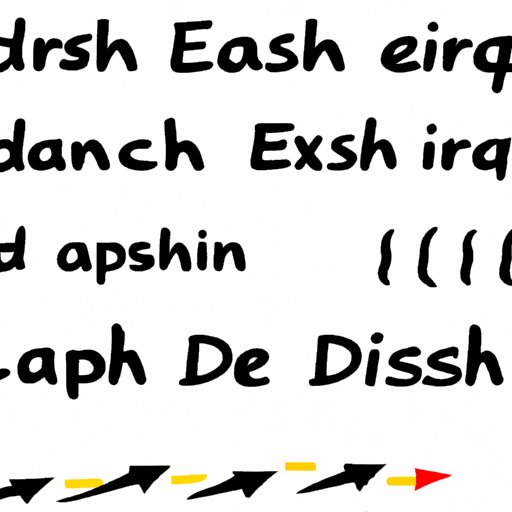
An Overview of Dashes in Writing
Dashes are punctuation marks that are often used to indicate a break in the flow of a sentence. They can be used to add emphasis, create suspense, or introduce parenthetical phrases. Although they are similar to hyphens and other punctuation marks, dashes are distinct in that they have their own unique purpose and style.

Explaining the Different Types and When to Use Them
There are three primary types of dashes used in writing: the em dash, the en dash, and the hyphen. Each type serves a specific purpose, so it is important to know when and why to use each one.
Em Dash
The em dash (—) is the longest of the three dashes and is used to signify a sudden break in thought or to set off a parenthetical phrase. It is usually twice as long as a hyphen and is not normally surrounded by spaces. For example: “The movie had an unexpected ending—it was a real shocker!”
En Dash
The en dash (–) is slightly shorter than the em dash and is typically used to indicate ranges, such as dates or numbers. It is also used to represent a connection between two things. For example: “The band will be on tour from August–September.”
Hyphen
The hyphen (-) is the shortest of the three dashes and is mainly used to join words together or break up syllables. It is also used to indicate fractions and compound adjectives. For example: “The two-hour meeting was surprisingly productive.”

Crafting Clear Sentences with Dashes
When used correctly, dashes can help to make sentences more concise and clear. Here are some tips for using dashes effectively:
Capitalize the first letter after an em dash
When an em dash is used to introduce a phrase or clause, the first letter of the following word should be capitalized. For example: “I was surprised—It was a pleasant surprise.”
Avoid overusing dashes
Dashes can be useful for emphasizing a point, but they should not be used too frequently. Too many dashes can be distracting and make your writing seem cluttered. The best practice is to use them sparingly.
Use dashes to separate or emphasize a clause or phrase
Dashes can be used to separate a clause or phrase from the rest of the sentence for emphasis. This can help to draw attention to the words that follow. For example: “He was determined to succeed—no matter what it took.”
Making an Impact with Dashes
Dashes can be used to emphasize a point, add suspense, or draw attention to certain words. Here are some examples of how to employ dashes to make a point:
Use dashes to draw attention to the words that follow
Dashes can be used to set off a clause or phrase and draw attention to the words that follow. This is especially effective when you want to emphasize a point. For example: “She was determined to prove her critics wrong—once and for all.”
Use dashes to emphasize a point
Dashes can also be used to emphasize a point. This can be done by setting off a clause or phrase with dashes and adding extra emphasis to the words that follow. For example: “He was determined to do the impossible—the impossible task of winning the race.”
Use dashes to add suspense
Dashes can be used to create suspense by introducing a pause in the sentence. This can be effective when you want to create tension or draw out a moment. For example: “He stood there, unsure of what to do next—until finally, he took a step forward.”
The Power of Parentheticals
Dashes can also be used to add meaningful context to a sentence. Here are some tips for how to use dashes to add meaningful context:
Use dashes to introduce a side note, tangent, or comment
Dashes can be used to introduce a side note or comment. This can be a great way to provide additional information without interrupting the flow of the sentence. For example: “We had a great time—though it was cut short due to the rain.”
Use dashes to add emphasis to a parenthetical thought
Dashes can also be used to add emphasis to a parenthetical thought. This can help to draw attention to the words that follow and make them stand out. For example: “We had a great time—an unforgettable experience.”
Use dashes to set off a quotation
Dashes can also be used to set off a quotation. This can help to differentiate the quote from the rest of the sentence and draw attention to the words that follow. For example: “He said, ‘It was a great time—one I won’t soon forget.'”
Breaking Up Long Sentences
Dashes can also be used to break up long sentences and make them easier to read. Here are some tips for how to use dashes to increase readability:
Use dashes to break up long sentences
Dashes can be used to break up long sentences into smaller, more manageable chunks. This can help to make the sentence easier to read and understand. For example: “John had been working hard all day—but he wasn’t tired yet. He kept going—determined to finish the project before the deadline.”
Use dashes to create dramatic pauses
Dashes can also be used to create dramatic pauses. This can be effective when you want to draw out a moment or add tension to a sentence. For example: “He was about to give up—when suddenly, he found the strength to keep going.”
Use dashes to signal a change in thought or direction
Dashes can also be used to signal a change in thought or direction. This can help to make the transition smoother and more seamless. For example: “He was determined to succeed—so he refused to give up. No matter what happened—he would keep going.”
Grammar Rules for Dashes
Finally, it is important to keep in mind some common grammar rules when using dashes in writing. Here are some guidelines to follow:
Use dashes sparingly
As mentioned above, dashes should be used sparingly. Too many dashes can make your writing seem cluttered and can be distracting for readers. The best practice is to use them only when necessary.
Always use a space before and after an em dash
When using an em dash, it is important to always include a space before and after the dash. This helps to ensure that the dash is properly formatted and that it stands out from the surrounding text.
Don’t combine hyphens, en dashes, or em dashes
It is important to avoid combining hyphens, en dashes, or em dashes in the same sentence. Each type of dash has its own specific purpose and style, and combining them can lead to confusion.
Conclusion
Dashes can be a powerful tool for writers. When used correctly, they can help to add emphasis, create suspense, and break up long sentences. It is important to understand the different types of dashes and when to use them, as well as the grammar rules that apply. With these tips in mind, you can craft clear, powerful sentences with dashes.
(Note: Is this article not meeting your expectations? Do you have knowledge or insights to share? Unlock new opportunities and expand your reach by joining our authors team. Click Registration to join us and share your expertise with our readers.)
